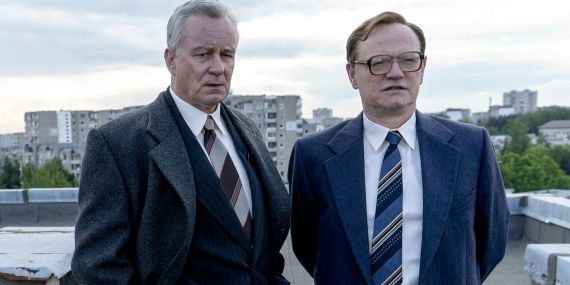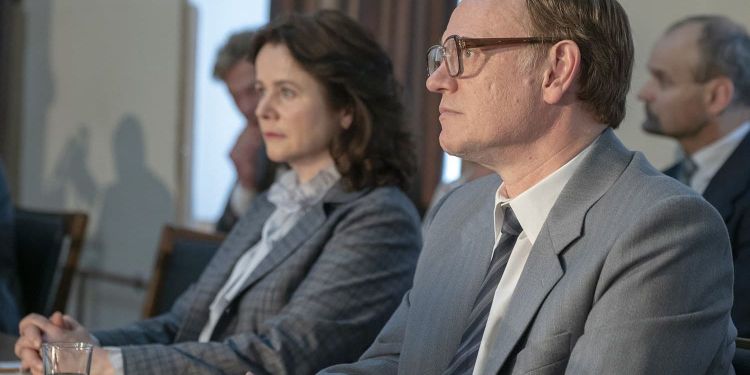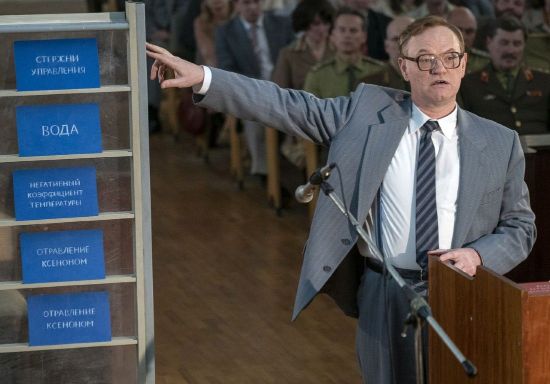The historical dramatisation of the Soviet-based nuclear disaster in 1986, titled Chernobyl, debuted in May 2019 and has since received accolades for its potent depiction of the disaster’s events. The powerful television series recounts the Chernobyl tragedy using numerous first-person stories from locals and scientific recollections. The show is renowned for its skillful build-up with only five episodes and its ability to highlight the less well-known experiences of residents and first responders.
The conclusion, “Vichnaya Pamyat,” brings together all of the intricate disaster’s various moving pieces and points of view. In a gripping but intense episode, the show travels through time to reveal to viewers what actually transpired at the nuclear power plant. The concluding episode of Chernobyl is a jigsaw that needs to be put together because it combines a crash education in nuclear physics with a grim conclusion to an attempt at doing the right thing.
Leading Up to ‘Chernobyl’s Courtroom Scene
In the wake of one of the worst nuclear disasters in history, the popular miniseries follows three main characters: Valery Legasov (Jared Harris), the head of a nuclear energy organisation; Boris Shcherbina (Stellan Skarsgrd), the deputy chairman of the Council of Ministers; and Ulana Khomyuk (Emily Watson), a fictitious nuclear physicist created to represent the scientific community. The three act after a nuclear power plant incident results in a significant radioactive explosion. Thousands of individuals are believed to have perished as a result of the accident’s extensive impacts, and many more were forced to leave their homes permanently as a result of the high radiation levels that persisted even in 2023. The three work to determine what caused the nuclear explosion while avoiding further harm, evacuating communities, and gathering accounts. As a result of their efforts, a second-by-second narrative of that night’s events is created.
Twelve hours before the catastrophic explosion, a crucial moment begins the Chernobyl series’ conclusion. Three management representatives from the power plant had a brief meeting: Director Viktor Bryukhanov (Con O’Neill), Chief Engineer Nikolai Fomin (Adrian Rawlins), and Deputy Chief Engineer Anatoly Dyatlov (Paul Ritter). Dyatlov and Fomin talk about how factory upgrades will probably result in them getting promoted, particularly if the doomed safety test goes well that day. This safety test’s goal was to determine how long the generators would continue to supply electricity in the event of a shutdown.
Bryukhanov adds that the plant must wait until midnight to perform the test rather than completing it during the day due to a call from the grid controller over production quotas. Dyatlov answers affirmatively when asked if it is safe to maintain the electricity at the same level for 10 hours, but viewers later find out that this was untrue.
Legasov is currently debating whether or not to disclose the truth about the incident in a Soviet courtroom after delivering a fabricated statement in Vienna in which he claimed that the nuclear catastrophe was the result of a “operational error.” He has already been promised a promotion and numerous honours from the government, but he is unable to get over Khomyuk’s nudge to disclose the truth. He is held back by his dread of speaking the truth and promoting reform in front of those who would not agree with him, would not put up with him, and would even endanger his life.
A Retelling and Explanation of the Chernobyl Disaster
As witnesses in the trial for Dyatlov, Bryukhanov, and Fomin, who are accused of being responsible for what occurred at Chernobyl, Legasov, Shcherbina, and Khomyuk arrive at the courthouse. Shcherbina begins by outlining the dubious and careless nature of testing the safety of the reactor that detonated in 1986 despite the fact that it had already been built and certified in 1983. The three defendants gave their approval for the reactor’s fast completion following construction, earning them each a government reward for completing the project so swiftly. They misrepresented its accomplishment, nevertheless, as a safety test wasn’t completely attempted until the night of the nuclear explosion, years later. Additionally, Shcherbina talks about how the three put everyone at risk by routinely employing risky techniques. In case the electricity went out, backup generators were used at the plant. The issue is that they would start up in a full minute, which is far too long when working with a nuclear reactor. The plant had tried this three times before with little success, and on the fourth try, an explosion took place. According to Shcherbina’s testimony, the three persons in command at the plant consciously used and continued with procedures that had previously failed.
The following witness, Khomyuk, transports the audience back to the day before the disaster. The day the test was first scheduled to take place was also this day. She goes into specifics of how the reactor itself had to be at a certain level for the test to function. However, it is decided that the test would happen at midnight instead after being postponed by grid controllers (as seen at the episode’s commencement). There was a shift change at midnight, which made this an even more disastrous error. This meant that the three supervisors left it up to the men working the night shift to complete the test rather than having the trained and prepared day shift workers do so. As the test was about to begin, heartbreaking flashbacks show the guys at the plant, some of whom had only been in their positions for a few months, hastily reading instructions for work they had never been given. Based on what we had observed about the working environment, some of the men in the control room that evening appeared to be afraid, and nobody felt completely at ease leaving the plant’s rigorous management.
The “Invisible Dance” That Led to the Chernobyl Accident
Legasov, who will serve as the last witness, will bring a visual aid that depicts the factors at play when balancing a reactor. Red cards on one side of his aid listed many things that make people more reactive. The blue cards on the other side are things that reduce reactivity. These components work together to ensure that a reactor is kept under control. For instance, water and control rods made of boron lower reactivity whereas uranium fuel increases it. A negative temperature coefficient is used to counteract the heat in the reactor, which causes steam to be produced from the water and increases reactivity. This is what Legasov refers to as the “invisible dance” that gives cities their strength.
The plant’s management made a mistake by leaving the reactor’s power at a standstill for 10 hours after the grid operators requested a delay. The test should have been rescheduled, but the reactor was left running at a reduced capacity for almost 30 minutes. Legasov refers to xenon as a “poison” to the reactor because it inhibits reactivity and was produced as a result of the long-term imbalance problem. This indicated that xenon was being produced over a period of time.
Flashbacks depict the moment panic set in, when people’s reactions started to drop off swiftly and mysteriously, a phenomenon Legasov called a “xenon pit.” The workers in the room start to see that something is seriously wrong, but Dyatlov forces them to continue. He commands them to submit to the test even as they start to resist him, threatening their futures and careers if they don’t. Dyatlov even makes an attempt to deny being present when this happened in court. This is stopped right away.
Levels reach 200 in the control room before stalling. 700 megawatts are needed for the safety test, but Dyatlov wants them to start at 200. Soon, the control room’s emergency alarms start to sound, and its computer suggests they turn the reactor off. Dyatlov nonetheless rejects.
The emergency shutdown button, which was intended to rapidly halt the reactor through the boron control rods, or so they believed, was the last step that caused the explosion as a result of their attempts at hasty, temporary solutions with something as delicate and risky as a reactor. According to the investigators’ results, the state has actually been using graphite-tipped boron control rods, which increase reactivity. Legasov finally decides to confront the Soviet authorities and tell the truth about all the reactors in the area, not just the one that detonated, after being questioned by the judge about why this was the case.
As Legasov wraps up by recounting those final moments before calamity, this discovery sparks a commotion in the courtroom. Only the graphite tips of the boron rods reach the reactor’s core when the control rods that were supposed to stabilise the reactor are initiated, so the control room personnel unintentionally set off the explosion. One of the most horrific nuclear disasters the world has ever seen occurs when high pressure breaks the reactor’s protective cap off, exposing it to oxygen. When Legasov is done telling the tale, the room is quiet.
The Aftermath of Telling the Truth
Legasov suspects that the government would retaliate against him for disclosing the defects in the reactors’ construction and calling for safer modifications. He is sentenced to a life without his legacy after telling the tribunal that the other 16 reactors in the region were built with the same fatal flaws. He is informed that all of his accomplishments and scientific discoveries would be attributed to others. Additionally, his testimony was withheld from the media and was successful in remaining silent in front of the public for a long time. He was placed on a blacklist, unable to find work in his field, and only kept alive by the government’s knowledge that Shcherbine was also slowly dying from radiation poisoning as a result of his continual proximity to the accident site.
What is beneath the surface is what gives the events of the climax such force. The three men who assist in managing the factory, especially Dyatlov, are portrayed as the only villains for the majority of the series. They behave abhorrently and frequently gaslight any factory employees who disagree with them. But towards the end, it is clear why they behave in this manner. The show illustrates an underlying issue with a system that hides secrets from individuals and puts them in danger. The common thread is how those in positions of authority take advantage of an already unhealthy hierarchy and disregard anyone who speaks the truth that is contrary to their own personal viewpoint. This has been a recurring theme since the first episode, just following the explosion. When a worker enters the plant, visibly affected by the escalating radiation, and tells that there is no core, Dyatlov appears to be either unaware of the situation or to be in a deep state of denial. Dyatlov describes the man as insane as he throws up on the ground. However, the show goes further to demonstrate that even people with some power, like Dyatlov, behave in certain ways because they were instructed to. But as evidenced during the trial, secrets were even concealed from him. If he had been aware of the design problems in the facility and reactor, would he have acted the same manner that evening? Most likely not. The Chernobyl television series illustrates how keeping secrets and things unsaid only causes them to explode.





